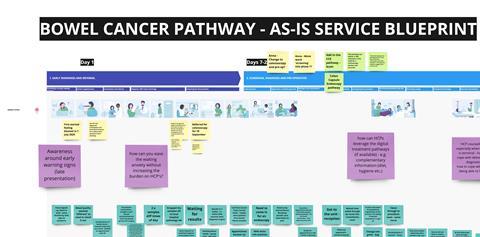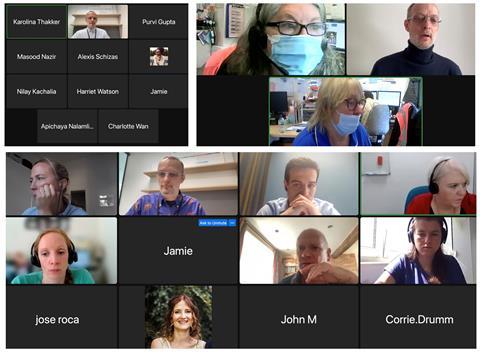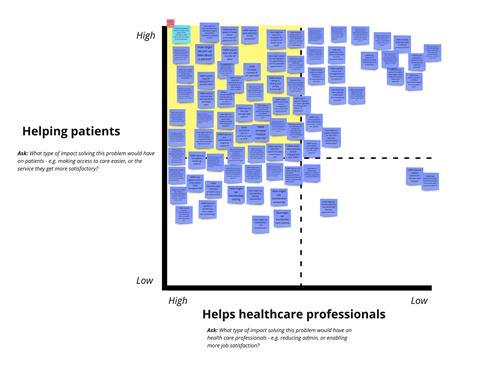80 experts, 80 hours, over 140 stress-tested ideas: a pop-up open innovation model shows us how combining talent from service design, digital technology, and healthcare can deliver results rapidly.
Sponsored by

Every day there are 120 new cases of bowel cancer diagnosed in the UK, making it the third most common form of cancer suffered by both men and women alike. Worryingly, the NHS is struggling to rise to this challenge under the current conditions, with burnout and exhaustion limiting the capabilities of healthcare professionals. The result is the failure to detect approximately 1,100 cases of bowel cancer every year, an especially alarming figure when we know that bowel cancer is “often a hidden” disease.
The urgent societal need for improved CRC care, coupled with the pressure faced by the NHS, drew the attention of innovation “do tank,” Fuzzy, and a dynamic provider of remote patient care technology, Spirit Health. United by a shared ambition to transform the CRC care pathway through human-centred design and digital technology, the two organisations joined forces to identify powerful ideas using an open, collaborative innovation model. This model prioritises positive outcomes for humans and enables talent from diverse disciplines to collaborate on a specific challenge.
Blueprinting and collaboration
The CRC pathway is highly complicated, so the team began by constructing a service blueprint to use as a foundation. We took a forensic approach to do this, collating the insights and experiences of CRC surgeons, nurses, and patients to find out exactly what happens, when it happens, and what simply does not work.

Next, we asked a series of “How Might We?” questions and used these to stimulate and ground a series of “idea hacks.” The HMWs are a design tool used to combine key themes and findings, such as the most important weak points, challenges, or unmet needs, to guide the generation of more useful ideas. Collaboration, diversity, speed and precision were at the heart of this project’s success. We used MIRO, an online collaborative whiteboard platform to create and test the ideas. The platform provided a way to work in a highly agile yet centralised way.

A glimpse of the main findings
Using the approach described, the diverse team leveraged the detailed pathway blueprint and HMW questions to come up with ideas that offer benefits for multiple groups involved in CRC care simultaneously.
It was critical to the team that ideas were generated that could quickly bring about impactful, relevant improvements, an ambition that is demonstrated in Idea 34. The team devised a way to enhance the accuracy and speed of patient triaging, which would involve a self-service system driven by an AI algorithm. This solution would process Faecal Immune Test data, alongside exist patient symptom and clinical information, to increase precision through automation. This innovative form of pre-referral testing would save significant time and cost for stretched healthcare professionals, and considerably reduce anxiety for patients and their families.

In the case of Idea 9, the team identified and tested a concept that would reduce the length and impact of waiting times and delays through the use of a risk stratification tool. The experts and patients named this idea the “Total and Holistic Risk Score,” which would analyse general patient medical information and early test results to assess risk levels in a more granular, data-driven way. This technology enabled solution would provide healthcare professionals with confidence, reduce patient anxiety, and enhance the overall effectiveness of diagnosis and treatment.

Another example of an innovative concept developed by the team is Idea 2, entitled “Medica Block,” which explores how the management of CRC care information can be enhanced using blockchain technology. This solution would use a common ledger as a way to register all patient information in a highly secure and decentralized manner. The goal of the concept is to achieve accessible, simple, and safe data transfer to prevent reconciliation issues, while improving the efficiency of the whole system.
The journey continues
We now intend to raise awareness about the exceptional results of the project by engaging with leading healthcare decision-makers in the NHS and across the globe, and championing our human-centric, design-led pop-up model. As part of this, leading members of the core team are prepared to participate in roundtables and other collaborative events that encourage open discussion and innovation. To find out more about our ground-breaking work and the methodology behind it, you can read the full whitepaper here.


























